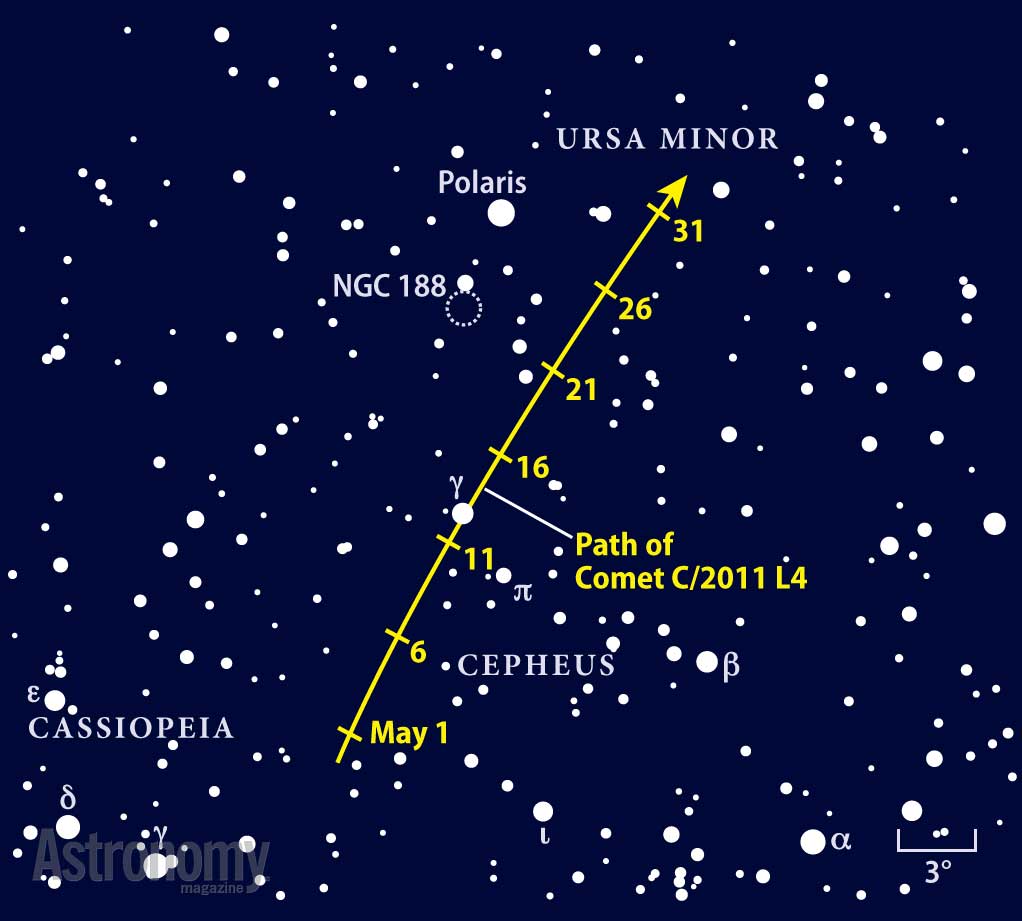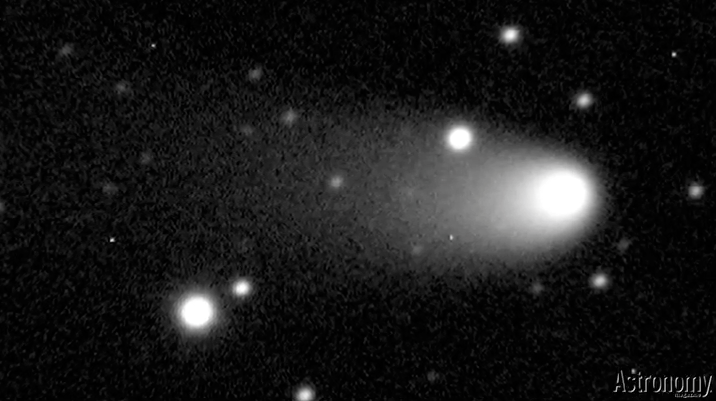The long wait is nearly over. Northern Hemisphere skygazers haven’t seen a bright comet with a long tail since Comet Hale-Bopp graced the night sky in 1997. But if predictions hold, Comet PANSTARRS (C/2011 L4) should be a nice naked-eye object and look impressive through binoculars after sunset starting in the second week of March.
Naked-eye viewers south of the equator watched the comet brighten nicely during February. In early March, Comet PANSTARRS veers sharply northward and gradually comes into view in the evening sky for observers at mid-northern latitudes. On March 9 and 10, it passes within 28 million miles (45 million kilometers) of the Sun and will stand some 7° high in the west 30 minutes after sunset. It also should glow brightest then, perhaps reaching 1st magnitude. A crescent Moon can guide you to the comet March 12 and 13. On the 12th, PANSTARRS stands to the upper left of our satellite; the next evening, the comet lies to the Moon’s lower right.
For complete coverage of Comet PANSTARRS, visit www.astronomy.com/panstarrs.
According to Senior Editor Michael E. Bakich of Astronomy magazine, the comet should remain visible for a full hour after the Sun sets. “This pretty much guarantees that you’ll be able to see Comet PANSTARRS from any location with reasonably clear skies and an unobstructed western horizon,” he says. “And if you view from a dark observing site, you still may be able to see the comet’s tail arcing among the stars even after the comet’s head sets.”
Although a 1st-magnitude star shines brightly, a 1st-magnitude comet doesn’t appear as dazzling. First, the comet’s light spreads over a much larger area than a pointlike star. Second, PANSTARRS will be battling twilight, reducing its contrast with the background sky. And third, after the middle of March, the steadily brightening Moon will likewise reduce the comet’s contrast. Your best bet is to locate Comet PANSTARRS through binoculars — which in any case should deliver the nicest views of the comet’s tail — before enjoying the naked-eye view.
If we’re lucky, Comet PANSTARRS should show two distinct tails emanating from a roughly circular glow. This glow, known as the head, or coma, masks the comet’s nucleus. The nucleus is a giant ball of ice and dust that measures up to a few miles across. As sunlight hits the nucleus, the ices boil off and carry dust with them. This cloud of gas and dust forms the coma. Sunlight ionizes the ejected gas molecules, causing them to glow with a bluish color. The solar wind carries this ionized gas away from the comet, creating a straight, bluish gas tail. The ejected dust gets pushed away from the Sun more gently, so it forms a curving tail that follows the comet’s orbit. The dust particles simply reflect sunlight, so the dust tail has a white to pale-yellow color.
Fast facts:
- Comet PANSTARRS reaches perigee — its closest approach to Earth — at 5 a.m. EST on March 5. It then lies 102 million miles (164 million kilometers) from our planet. The comet reaches perihelion — its closest approach to the Sun — at 11 p.m. EST on March 9. It then lies 28 million miles (45 million kilometers) from our star.
- Astronomers discovered the comet June 6, 2011. As the fourth new comet detected during the first half of June that year, it received the designation “C/2011 L4.” And because researchers first spotted the object on images taken through the 1.8-meter Panoramic Survey Telescope and Rapid Response System on Haleakala in Hawaii, it received that instrument’s acronym, PANSTARRS, as a secondary name.
- Comet PANSTARRS isn’t the only celestial visitor to look forward to in 2013. During November and December, Comet C/2012 S1 (ISON) could glow a thousand times brighter or even more.
- Special Coverage: Find everything you need to know about Comet PANSTARRS in Astronomy.com’s Year of the Comet section.
- Video: Get ready for 2013’s first naked-eye comet, with Senior Editor Richard Talcott
- StarDome: Locate Comet C/2011 L4 (PANSTARRS) in your night sky with our interactive star chart. To ensure the comet is displayed, click on the “Display…” drop-down menu under Options (lower right) and make sure “Comets” has a check mark next to it. Then click the “Show Names…” drop-down menu and make sure “Comets” is checked there, too.
- Images: Submit images of Comet PANSTARRS to our Online Reader Gallery.
- Discussion: Ask questions and share your observations in our Reader Forums.
- Sign up for our free weekly e-mail newsletter.













